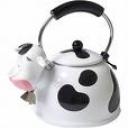Making meaning – how do customers and employees do it and how can we design artifacts that support the creation and experience of it?
An artifact or natural object becomes meaningful when I classify it or put it in a category. For example, I look at (and perhaps even smell) something moving in a field and pattern recognize it as a cow. The “something” now categorized as a cow has considerable meaning because I believe, feel, value and perhaps even know a lot about cows. I was able to categorize it because I perceived that it had a form, specific features (or properties) and behaved (or functioned) in a particular way. These 3Fs – form, features and functions matched my category, schema or mental model of a cow. That is general or public meaning.
There is also personal meaning that is created when the category is one that is particularly important to me because it reflects my values or meets a cognitive (intellectual, affective, motivational, volitional) need that I have. Continuing with the cow example, we have seen a consumer crazy with cow toys, stuff animals, collectibles, pottery, pictures, gifts, t-shirts and the like appearing. For marketing fans there is also the famous “Purple Cow” created by Seth Godin by his book by that title.

Why the consumer fascination with cows? What personalized meaning is being created? What previously unmet cognitive need is being satisfied?
I raised these questions last year with a group I was training in a large corporation in the food industry. They went out and analyzed cow artifacts and developed psychographic profiles for people that were consuming them. The psychographic profiles are like socio-economic profiles only instead of focusing of where you live and how much you make they focus on how you think, learn, make decisions, emotionally react and other key aspects of your cognition.
I cannot share the specifics of what they found but in general terms they found cow symbols creating personalized meaning because, for example, cows are big but lovable, a part of the great American west, the subject of many jokes, stories and a focus of concern for humane treatment.


The Purple Cow was understood as a juxtaposition effect creating novelty and surprise – after all cows are not purple. Point being that if we are going to design artifacts (experiences, products, corporate events, etc.) that create or enhance personalized meaning for customers and employees we need to understand the underlying psychographic profile we are trying to meet.
In cognitive design, psychographics goes beyond values (what the user holds to be important) to include how they reason (e.g. are specific biases involved), how they structure the mental content (e.g. metaphors, archetypes, gestalts), what core beliefs or mental models are involved (especially if they are faulty), what types of emotional and other visceral responses are they prone to and a host of other factors.
I contrast psychographics to a values-based approach to open the window a bit and get additional insight to guide the design process. For example, check out the 15 meanings (general profiles) that Steve Diller and his colleagues have documented from their research into meaningful customer experiences.

The profiles include, for example, duty, freedom, truth, enlightenment, justice and oneness. All value-based categories and if I know which of these are operating in my target market I have valuable insights for design.
Now imagine I can go a step further and determine that not only is “Justice”a key meaning maker for my users but that they understand it in terms of two core metaphors – journey and control (see my earlier post on Zaltman’s new book on deep metaphors). This provides even more design information to help me shape the 3Fs (form, features and functions) of the artifact to fit how the minds of my consumers or employees work.
“Justice” defined by Diller as a type of meaning is “The assurance of equitable and unbiased treatment”. To be most effective in designing experiences based on this form of meaning we need to understand how user reason about justice – what is their calculus of equitable and unbiased? I demonstrate the importance of this in an earlier post (designing for trust) that discusses service recovery. Over compensation during service recovery can lead to consumer guilt, under compensation can lead to anger.
Meaning, especially personal meaning is created by a complex cognitive process that includes, values, emotions, metaphors, images, mental models, reasoning rules and the like. To enhance or create meaningful experience for employees and customers we need to understand not only what values transform public meaning into private meaning but the mechanics of how that is done.





